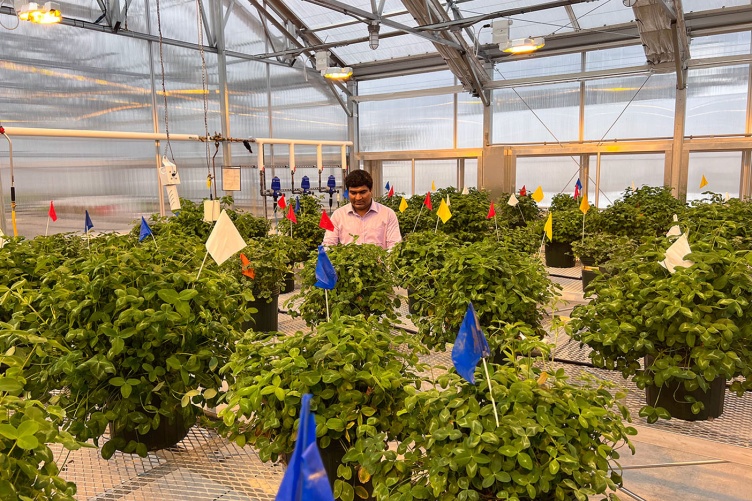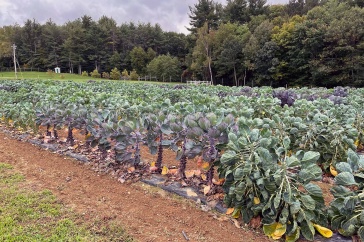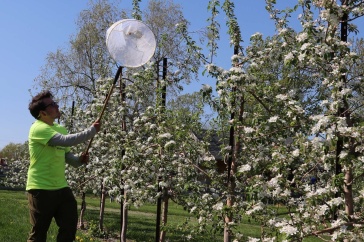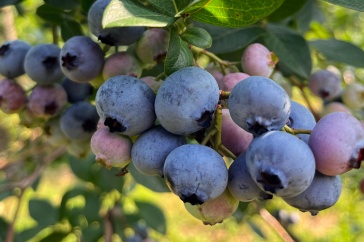Key Finding
Under drought conditions, the forage crop red clover increases its phytoestrogen levels—estrogen-like compounds that can adversely affect livestock reproductive health. Phytoestrogen levels in kura clover are extremely low and not affected by drought conditions, suggesting it might serve as a promising forage crop alternative to red clover as weather in the Northeast becomes increasingly variable.
For U.S. dairy farms, cows that have difficulty initiating and maintaining pregnancies can cost as much as $484 million annually in veterinary care and lost milk production, according to the USDA National Animal Health Reporting System, threatening farms’ long-term sustainability. One contributing factor could be the levels of phytoestrogens—compounds similar to estrogen but derived from plants—in cow’s feed. Researchers with the New Hampshire Agricultural Experiment Station (NHAES) at the University of New Hampshire found that red clover, a crop commonly grown in the Northeast for animal feed, produces higher levels of phytoestrogen during droughts but that another species may be less susceptible.
In a recent study published in the Journal of Agricultural and Food Chemistry, a team of researchers—including NHAES scientists Rich Smith and Andre Brito and lead author and UNH agricultural science doctoral student Palash Mandal—found that drought conditions doubled the amount of phytoestrogenic compounds in red clover (Trifolium pratense), a crop used extensively for pasture and hay in New England. Conversely, kura clover (Trifolium ambiguum)—a relatively new pasture crop recognized for its ability to grow in waterlogged areas, low-nutrient soil, and variable climatic conditions—showed no increase in phytoestrogen content.
The increases in phytoestrogenic compounds found in red clover represent a defense mechanism, protecting the plant from adverse conditions, according to the study. The longer red clover was exposed to drought conditions, the greater the increase in phytoestrogen compounds.
“Different plants have evolved various mechanisms to cope with environmental stress. Red clover’s response is to produce more phytoestrogen, whereas kura’s stress response was more stable and resulted in low or undetectable phytoestrogen levels,” Mandal said. “As our weather in New England becomes more variable and we continue experiencing greater periods of drought and flooding, it will be important to know how different crops respond to these varied conditions.”
The study’s results suggest that kura clover may be a promising forage crop alternative for Northeast dairy farmers as climate change leads to longer periods of drier and wetter weather. Not only do its phytoestrogen levels remain stable, but kura clover is also reported to persist in pastures longer than red clover. One caveat, however, is that kura clover can be difficult to establish in pastures in the Northeast.
“We can easily grow kura clover in the greenhouse, but we’ve had limited success getting it to reliably establish in our research farm trials, even though it’s commonly grown in the upper Midwest,” said Smith, adding that they continue to study why this occurs.
While red clover grows well in the Northeast and is an excellent forage legume, more research is needed to better understand how its phytoestrogen content can impact the reproductive health of dairy cows.
“We are learning that, even under ideal conditions, red clover produces relatively high levels of phytoestrogens compared to the other legumes we’ve tested, including white clover, alfalfa, and birdsfoot trefoil,” Smith said. “Under certain conditions, red clover will significantly increase its phytoestrogen content. Dairy or other livestock farmers concerned about phytoestrogens might want to consider other similarly high-quality forage legumes that are non- or less phytoestrogenic.”
Palash added that farmers can use the results of this study to manage their forage crops more effectively. For example, it may be best to limit red clover or avoid grazing and harvesting it when it is drought-stressed to keep cattle’s phytoestrogen consumption low.
The study was conducted at UNH’s Macfarlane Research Greenhouses, where the researchers simulated various drought and flooding conditions to red and kura clover to mimic the intermittent droughts and heavy rainfalls New Hampshire has experienced in recent years. The team also varied the amount of time the plants were exposed to these treatments, either 10 or 20 days, modeling what might occur under longer periods of water stress.
In the future, Mandal plans to study what other factors influence phytoestrogen levels in red clover so that farmers can consider those factors when planning their land management practices. Potential influencers include temperature and soil mineral deficiency, the presence of fungal diseases or insects, or how the forage crops are processed.
“Establishing a baseline of phytoestrogen levels in forage crops and learning what other factors may raise phytoestrogen levels can further help dairy farmers establish forage diets that better protect the reproductive health of their cows,” concluded Mandal.
This work is co-authored by Palash Mandal, David A. Mortensen, Andre F. Brito, Anna K. Wallingford, Marta R. M. Lima, Nicholas D. Warren and Richard G. Smith.
To learn more about this research, read Water Stress Influences Phytoestrogen Levels in Red Clover (Trifolium pratense) but Not Kura Clover (T. ambiguum), published in the Journal of Agricultural and Food Chemistry.
This material is based on work supported by the NH Agricultural Experiment Station through joint funding from the USDA National Institute of Food and Agriculture (under Hatch award number 7000871) and the state of New Hampshire. Additional support came from the USDA NIFA Organic Research and Extension Initiative and the Northeast Sustainable Agriculture Research and Education.
-
Written By:
Nicholas Gosling '06 | COLSA/NH Agricultural Experiment Station | nicholas.gosling@unh.edu






















































